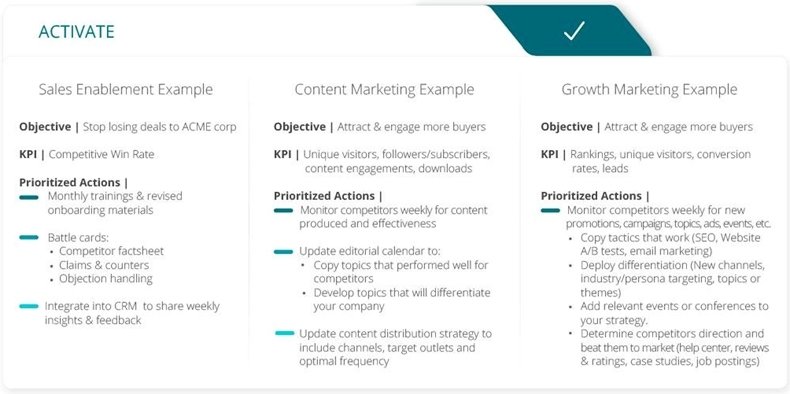What are you trying to achieve out of your competitive intelligence program?
When you're in a crowded market or you're the market leader, it can feel like you have a million priorities. Getting wrapped up in a big project or a million little tasks that-need-to-get-done-or-the-sky-is-going-to-fall... is a real feeling.
However, for product marketers, competitive intel (CI) should be at the front of the line. Understanding the landscape and current happenings are essential to be successful against competitors. If you're not defining your CI priorities, like most projects, it's being set up for failure and can be costly for your business.
Strive for progress, not perfection. Not everything is equally important—so you need to focus efforts on the areas that are going to align closely with your overall objectives.
Outside of knowing what you want to accomplish, how do you define your CI priorities? Kompyte recently surveyed product marketers, growth marketers, and sales enablement professionals and found that 30% of them don't have a process for collecting and taking action on competitive intelligence. Another 55% said they do ad hoc competitive initiatives or their process is highly manual. Only 2% have prioritized competitive intelligence programs or initiatives.
Those findings got us thinking: If companies believe CI is essential, why wouldn't they prioritize it as such?
Competitive intelligence is a strategic imperative: It can be used in many facets of the business and it can impact a variety of business functions. However, how you define your competitive priorities may vary, depending on the areas that matter to your business.
Why is it important to define your CI priorities?
Have you ever found yourself wandering through a store and you realize by the time you get to the register that you've spent more time than you were expecting and you didn't get half of the things on your list? The same is true for your competitive initiatives. Without a clear definition of what success looks like, things can quickly go awry.
For example, here are some risks that accompany undefined goals:
- Trouble managing time and making progress on overall goals. In addition to a lack of definition, making progress on something that isn't clear is even harder.
- A decrease in follow-through on commitments. Without a clear goal in mind, the number of tasks on your to-do list might become overwhelming.
- Inability to say no. You become a yes-person. You're under the illusion that you can do it all.
- Actions are reactive instead of proactive. Work is always a mix of reactive and proactive tasks—some days are better than others. However, if you're stuck in a reactive state, important tasks will end up continuously getting pushed back.
- Unable to quickly and confidently make decisions. You lack clarity on KPIs, and long-term goals.
At the end of the day, you're not alone. Defining how you use and benefit from competitive intelligence can take time, but if done correctly, it can be incredibly impactful.
So how do you get started? After sitting down with some of the survey respondents, we pulled the common best-practices their teams follow.
Try these three best-practices
1. Set time aside to do it
What we heard most from product marketers is that although finding time was hard, once they set time aside to set the goals and align them, it felt like everything else fell into place.
Making time can be a challenge, but CI programs don't prioritize themselves. If you get caught in a reactive state and you are unable to make quick decisions, productivity will drop and the likelihood of hitting business goals will rise.
2. Draft a list of priorities and assess the importance
Based on your responsibilities, what are all the things you could do to win business and meet your KPIs?
Now stop. You're not going to be able to accomplish anything with a spray-paint-like approach. Start by thinking about the goals by function and how important they are to the overall success of your business.
For example, if you're the product marketing team, your objectives and level of importance are going to be quite different from the sales enablement team's. However, there most likely will be overlap. Since each function might have a different focus, defining the CI priorities should be paired with metrics.

Once you have a list of all the "high-level" priorities, refine that list. You're not going to boil the ocean at once; if you try to do it all, the likelihood of producing higher-quality work diminishes. Identify business-critical CI items like product launches and seasonal or short-term marketing promotions.
The priorities are going to range from foundational to proactive competitive initiatives, so keep in mind the metrics you're going to be measured on and plan accordingly.
3. Continue to review and update
As with most things, priorities change; they're not set in stone. Once you've clearly outlined the goals, they're easier to come back to if they're put on hold. As you gain insights from competitive intel, you need to check in on your priorities. Defining them is not a set-and-forget notion. They need to be reviewed and updated regularly. If your priorities are organized and aligned, you'll be able to make decisions and appropriately react to competitor updates quickly; they act as a guide for how to approach different opportunities resulting in the most value.
* * *
For any business, setting goals is crucial to measuring growth and reaching success. To adequately do that, rapid iteration is key. CI is meant to be a tool used to improve strategic positioning and align with company objectives. If a company objective changes or is updated, the CI priority that aligns with it will need to be reviewed as well.




